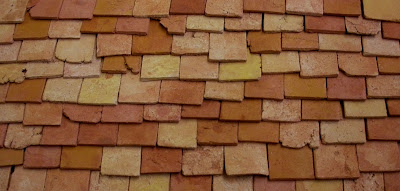
A lovely old building in a beautiful public garden in Cambremer, France. Great place for lunch too, they serve crepes at those tables. I went back twice and took many photos of the restored timber framed buildings on the estate. But what I am posting this photo for is the view of the charming red tile roof that covers the structure.
Tired of dealing with making timbers and sawdust today I turned to another task I need to accomplish for the new dollhouse, making roof tiles.
I had experimented with achieving the look I wanted a few years back when I first started this project so today I got out the box of materials to get back to working on achieving the perfect, flat, terracotta roof tile (tuile plate).
One thing to figure out was the dimensions of the tiles. I needed to know the height, width and thickness. For that I searched around and found some places on the internet selling antique, salvaged tiles, they listed the dimensions. Naturally there was some variation of size between lots of tiles on different web sites. These materials were not ordered from the big box stores, they were locally made products, hand crafted.
Colors vary a lot from tile to tile even on the same roof. There might have been a different batch of clay dug from another section of the pit.They might have been fired in a different section of the kiln. They could have been fired on different days at differing temperatures.
All that color variation means I can't open up a package of terracotta air dry clay, roll it out, cut to size and glue it on the roof. I have to make small batches of a wide range of terracotta colors. I am using the Plus brand of air dry clay from the Activa company. I will vary the color with universal tinting mediums from the paint store as well as natural powdered earth pigment. I make small batches of the clay and mix them in a small food processor. I run it through a pasta roller a few times to blend it some more. If the mix does not feed through the pasta roller easily adjust the mix with more liquid or add more clay or earth pigment. It takes trial and error until you get used to the feel of what a good mix is for rolling. A little color streaking is a treasure to be enjoyed and very authentic.
After it comes out of the pasta machine I place the rolled piece between two pieces of flexible cutting board and roll it with just a little bit of pressure using a regular rolling pin. Then I cut it into tiles using a straight edge and a scalpel. The thin, very sharp scalpel leaves nice sharp edges on the tiles without rounding over the edge.
A hundred small batches of a thousand tiles and the job will still not be done. Further color variations will be added with watercolor washes. The paper-mache clays do tint nicely with watercolors. Then I will have hundreds of subtle shades of tiles on my dollhouse roof. You can understand why I have to get an early start on it, I will be making roof tiles for many weeks to come. This is a very labor intensive process but the results are totally worth it.
The next two photos show authentically aged roofs. These are photos I took on my trip to Normandy. Now if I can just achieve something even close to being as interesting. Try not to turn to other peoples dollhouses so much for your inspiration, instead do image research and try to achieve on your dollhouse a feeling of reality from life. There are thousands of these inspirational old buildings still standing in Europe although it does look like that building won't be around for long if the roof is not patched up. The sign in the dormer window say "a vendre", that means the place is for sale, what a fixer!

























